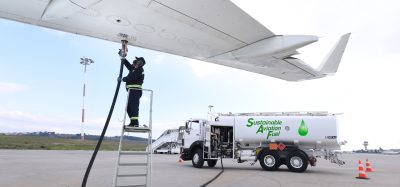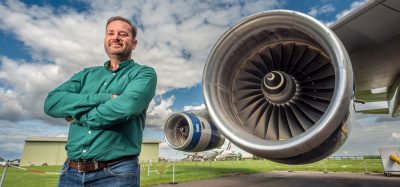From ‘Afterthought’ to ‘Cutting Edge’?
- Like
- Digg
- Del
- Tumblr
- VKontakte
- Buffer
- Love This
- Odnoklassniki
- Meneame
- Blogger
- Amazon
- Yahoo Mail
- Gmail
- AOL
- Newsvine
- HackerNews
- Evernote
- MySpace
- Mail.ru
- Viadeo
- Line
- Comments
- Yummly
- SMS
- Viber
- Telegram
- Subscribe
- Skype
- Facebook Messenger
- Kakao
- LiveJournal
- Yammer
- Edgar
- Fintel
- Mix
- Instapaper
- Copy Link
Posted: 3 December 2008 | Richard L. Altman, Executive Director, Commercial Aviation Alternative Fuels Initiative (CAAFI) | No comments yet
CAAFI progress in advancing aviation alternative fuels.
CAAFI progress in advancing aviation alternative fuels.
One year ago International Airport Review readers were introduced to the Commercial Aviation Alternative Fuels Initiative (CAAFI). CAAFI’s genesis, its structure and its accomplishments were listed. Readers were left with the question “Will aviation be the last to wean itself from petroleum fuel or will it be a “first mover” to a very different future?”
Lastly there was a conclusion that airports would play a ‘key role’ in implementation. Left open – what is this role in an arena where airports have typically had limited engagement? What is at stake for airports?
What follows is an update that answers the first of these questions and adds granularity to the stake that airports have solutions.
CAAFI and its 250 sponsor and stakeholder participants have done much during the course of the last twelve months to move from an ‘afterthought’ to being on the ‘cutting edge’ of innovation, by manifesting progress in two ways.
First, the efforts of CAAFI’s airline, manufacturer and FAA sponsors in particular have converged on priorities. Policy directives in the U.S. have both been responsible and in other cases have responded to result in this convergence.
Second, the efforts of the CAAFI coalition, through its Certification, Environmental and Economic teams, are developing solutions to support sponsor/supplier policy framework. All steps increase the certainty of potential fuel suppliers, that their potential fuel candidates can be confident of successful early implementation in aviation.
Progress reported by CAAFI R&D team members has also increased the potential number of ‘drop-in’ fuel candidates. Globalisation through efforts in the European Union, ICAO and across the energy sector confirms a similar trend.
Sponsor stakeholder policy convergence
Sponsor and stakeholder convergence on alternative fuels occurred via parallel policy thrusts in the private and public sector:
- In April, the Air Transport Association, representing North America, agreed to an alternative fuels policy “designed to bring cleaner jet fuel alternatives to market while ensuring safety, increasing reliability and promoting economic feasibility” (see full statement at http://www.airlines.org/economics/ altfuelsprinciples.htm)
- The ATA environmental position closely aligned with the provisions of the U.S. Energy Act under section 526. It requires that government purchasers select fuel alternatives that are better in greenhouse gas output than those of oil refineries.
The effects of this policy convergence are evidenced in actions that have helped to focus energy suppliers and airlines in four areas:
- Potential early mover Fischer Tropsch fuel producers such as; American Clean Coal Fuels, Baard Energy and Rentech have focused their efforts on combined coal/biomass production opportunities in facility designs. These facilities can provide as much as 60% of their production to aviation. Biomass contributions offset the uncertainties of meeting GHG environmental criteria without using food crops or feedstocks not grown locally
- Renewable option blends from alternative processes such as Hydrotreated Renewable Jet (HRJ) developed in the U.S by such companies as GE, UOP and the University of North Dakota under contract to DARPA are in play. HRJ candidates include such feedstocks as algae, promising significantly higher yield per acre than current candidates
- The degree to which these policies offer aviation an opportunity is now reflected in the current U.S. Agriculture Department Farm Bill, including report language to “give equal consideration to projects. …that would perform innovative and beneficial research and commercial development of renewable aviation fuels”
- Lastly, concerns with tax policy discrimination against jet fuel from either non-renewable or renewable sources (vs. other transportation modes – e.g. corn ethanol for cars) were eliminated in recent financial rescue legislation. These fuels are now candidates for the same 50-cent tax incentive as ethanol receives.
CAAFI team respond to key implementation needs, broaden R&D
Given sponsor/stakeholder convergence, CAAFI’s functional teams, described to IAR readers a year ago, are addressing three critical needs. The needs and the actions address:
1. Elimination of time to certification as an Issue for supply development – Certification Team
Certification efforts during the first half of 2008 featured actions by certification bodies’ teams composed in part of CAAFI sponsor/stakeholder members.
Key CAAFI stakeholder the U.S. Air Force approved the use of up to 50/50 blends of generic Fischer Tropsch fuels under its JP8 specification Mil-Spec 8133. In the same timeframe, the UK Ministry of Defence led certification process approved the use of 100% Sasol use from Sasol’s South African facility.
In process now are parallel actions by commercial authorities, operating under the umbrella of the American Society of Testing and Materials (ASTM). CAAFI is urging ASTM to move its process forward by both speeding actions to parallel the military move on the analogous Jet A fuel blends and to adopt a new D-XXXX process longer term, to move beyond feedstock limitations of the Jet A current D-1655 specification.
CAAFI has added a renewable biofuel blend certification as early as 2010. The goal is to remove certification timing as a determinant of alternative fuels availability.
2. Methods to prove that Greenhouse Gas “well to wake” assessments are better than oil refineries. – Environmental Team
Greenhouse Gas Life Cycle Analysis assessments from nine presenters of analyses frameworks, Fischer Tropsch processors and Renewal biojet processors – an approach was agreed to that leverages the unique strengths of aviation to inclusive outcomes and reduce uncertainties among suppliers – these include:
- USAF/DOE assessment rules and tools emerging from a joint government/industry/university team, to assess specific alternative fuel production and distribution options uniformly
- Use of FAA/ICAO globally accepted aviation emissions forecasting tools for aircraft emissions output
- Case studies of planned production and distribution of alternative fuel projects offered by stakeholder using a) and b) to ensure that full range of facility/process/site unique issues can be evaluated and bounded accurately
- Expand airline buyer/candidate producer dialog to enable early deployment
On September 8-9 the U.S. Department of Commerce and CAAFI’s ATA, and FAA sponsors executed a Business and Economics team meeting at the Department of Commerce in Washington, D.C.
The session brought together representatives of 20 fuel buyers (15 airlines), 26 energy suppliers and 13 U.S. Government agencies.
The session recorded progress in three definitive areas:
- The quality and quantity of dialogue between potential sellers and buyers of aviation fuels increased dramatically
- Eight specific areas for production technology enhancement for FT bioblends were identified
- Efforts to cooperate across CAAFI teams and with the USAF on biofuels advanced with discussions of the range of Hydrotreated Renewable Jet fuels to include fuels from other processes (fermentation) and feedstocks (algae).
This last outcome is now focusing CAAFI’s R&D team in its efforts on all feedstocks, from Jatropha to algae alternative processes.
Business and R&D roadmaps, to guide potential government investments in all of the areas above for Stakeholder and Sponsor, for use by sponsors and stakeholders are in process.
Focus beyond the U.S. in the energy sector
The promise identified in the convergence of policy interests and progress by CAAFI teams is attracting attention internationally and in the energy sector.
- The European Union is launching a research program that parallels and is complementary to CAAFI activities. Research proposals were provided over the summer. Contract awards are possible early next year according to CAAFI’s European stakeholders
- The aviation arm of the United Nations, the International Civil Aviation Organisation, is now scheduled to hold a workshop at its Montreal Headquarters this February expanding efforts to all countries
- In the energy sector CAAFI is co-sponsor and is organising the aviation track for the 10th annual European Fuels conference, scheduled for Paris in March
- Several international consortiums consisting of manufacturers, such as Rolls Royce, Airbus, Boeing and Pratt & Whitney, have teamed with airlines to move the aviation alternative fuel agenda.
An opportunity for airports via alternative fuels?
What is the opportunity environmental and supply stability from focusing on alternative fuels?
- With their unique and concentrated supply systems, airports represent a concentrated distribution infrastructure for fuels. In the U.S. 80% of all supplies enter through 35 airports. This is important and increasingly attractive economically if the airport is given an incentive to distribute fuels off airport
- Airports can benefit environmentally from dramatically lowered levels of small particles, P.M. 2.5 resulting from alternative fuels. CAAFI’s environmental team has confirmed gains of as much as 90% in this pollutant this year
- Protection from localised price increases and supply disruptions, that have led to as much as a $30 per barrel premium for jet fuel supplies, could make airports with expandable alternative fuel options significantly more attractive to operators making long-term commitments to new sites
- By achieving low sulphur levels, airport expansions can utilise a single fuel type for both ground vehicles mandated to use ultra low sulphur fuels and ultra low sulphur aviation alternatives.
Actions airports can take
Several paths are available to quantify and to take advantage of the emerging opportunity for alternative fuels:
- Quantify cost/benefits of alternative fuels by encouraging the development of analysis tools such as the Airport Cooperatives Research Program (ACRP 02-07) pending airport handbook. These tools should be used to conduct dialog and obtain a mutual understanding with prospective fuel suppliers
- Airports impacted by small particles issues in expansion programs should be identified for early alternative fuel insertion to permit growth within a framework of local regulations, such as those of the U.S. Clean Air Act
- Participate actively in forthcoming infrastructure teams with on-airport fuel suppliers such as ASIG, pipeline companies and fixed base operators
- Alternative fuel policies, to encourage off-airport distribution, and equal taxation of aircraft and ground use should be examined.
In closing, it is important to note that the commitment to alternative fuels is likely to increase in the months ahead, exclusive of any short-term trend in oil prices.
In a statement to CNN four days before the election, then U.S. Presidential candidate Barack Obama stated that after the obvious number one priority of addressing the financial crisis, energy was his number two priority, stating that:
“We have to seize this moment, because it’s not just an energy independence issue; it’s also a national security issue, and it’s a jobs issue.”
The same can be said for commercial aviation. We can either ride the wave of alternative energy investment or can be left adrift as an afterthought. Most CAAFI sponsors and stakeholders are well positioned to ride the wave. Airports need to play a key role if we are to ride it to shore.

















